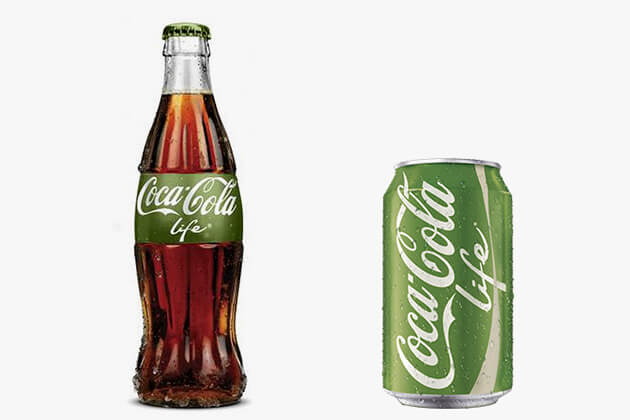About Time: We Questioned ‘Healthy’ Food LabelsBy Siobhan Norton
We’ve come a long way in the last few years when it comes to what we put on our plates. When is the last time you ate fruit out of a can? Or meat from a can, come to think of it? In supermarkets, the frozen food section is shrinking as more fresh produce becomes available, and everywhere we are offered convenient, pre-packed foods that are organic, natural, multi-grain, or made with real fruit. Free-from aisles are encroaching into the crisp aisles and it’s just as easy to grab a healthy snack bar as it is a chocolate bar when the 4pm slump hits.
So why are we not exactly glowing with health? In fact, why, as a nation, do we appear to be slowly getting fatter and sicker? Surely it can’t be down to our saintly diets?
The Problem
Food giants are no dummies – they can spot a trend before we even know it’s trendy. Coca Cola is the latest to jump with hobnail boots on to the healthy bandwagon with its new line: Coca Cola Life. It’s got a green label, so it must be healthy. Even more than that, it’s got green-smoothie-drinking health goddess Rosie Huntington-Whiteley fronting its campaign, so it must be legit, right? Well, yes and no. It does use stevia, a natural sweetener, in its recipe, lowering its sugar count. However, a 330ml can still contains 22g of sugar.
Is that a lot? Well, this year the World Health Organisation revised down its recommendations for sugar intake – to 5% of your daily calories. That’s an average of six teaspoons, or 25g a day. So a can of clean, green Coke Life will put you nearly at your limit.
WHAT?!?, you may exclaim. How can those EVIL corporate giants DUPE us like this? Well, unfortunately, very easily. It’s called marketing – and we’re being duped at every turn. Coca Cola isn’t the only one either – Pepsi, for example, is hot on its heels with Pepsi True. And, if you think about it, Coke Life hasn’t claimed to be healthy, not really. It’s called ‘Life’, which doesn’t mean anything (although I doubt you’d be queueing to quaff Coke Death). It hasn’t claimed to be low-sugar, just “less calories” (I’ll save the grammar rant for another article). There’s no crime in choosing a particular colour for a label. So technically, technically, it isn’t breaking any rules. Welcome to the weaselly world of marketing.
The Background
Clever labelling is not a new phenomenon. As long as diets have existed, so have reassuring promises of foods being low-fat, sugar-free, and containing all-natural ingredients. Pictures of glowing, white-teethed, tanned-limbed children grace the packaging and ads (Kinder Surprise, come on dooooown!)
Breakfast cereals are a case in point. They offer concerned mums (who obviously want the best for their children) lovely, vague advice. “Give them the best start to their day!” “Central eating for kids!” And the admittedly even more vague, “They’re grrrreat!” Ok, so sometimes they’re wholegrain, which is, erm, great. But they are often loaded with sugar. Loaded. And watch the portion sizes too: I can bet my collection of free bike reflectors that we all pour ourselves a bowl at least double the teeny recommended 30g portion size.
‘Grown-up’ cereals are just as bad. Special K has been around since 1956, and was always marketed as the healthy, weight-loss cereal. It is low-fat, but has as much sugar as Coco-Pops (11g per 30g serving, if you’re wondering). But clever marketing – including the iconic red swimsuit ads – has made us all believe that a bowl of Special K is a great start to the day. A Special K diet plan even advised us to have a bowl for lunch as well, plus a sensible dinner for great results. Perhaps people did get results, but a bowl of sugary rice and wheat flakes is hardly a substitute for lean protein and fresh vegetables.
The Special K diet was just one of the phenomenons riding high on the low-fat obsession that has existed from the 1960s. For decades we have been bombarded with low-fat products and all the promises that go with them, with even GPs wholeheartedly embracing the ideology. So we got low-fat yoghurts (crammed with sugar) and low-fat spreads (causing us to replace butter with carcinogenic trans-fats). All labelled with the words ‘light’ (and ‘lite’, grrr), ‘slim’ and ‘skinny’ and vague healthy-sounding words like ‘vitality’, ‘bounce’ and ‘nude’.
A low-fat backlash is emerging, and sugar is being recognised as public health enemy number one, but we may still be consuming far more than we think. One green smoothie in a high-street sandwich bar – with a reassuring ‘goodness’ on the label – contains a whopping 42g of sugar per serving. Forty. Two. A popular cereal bar (containing all “natural” ingredients) has 13g of sugar.
The Solution
We have to learn to think like a marketing whizz – and learn how to read labels. My rule of thumb is that if sugar is in the top three ingredients, don’t buy it. Of course, sugar can sneak in under a variety of healthier-sounding guises, including (deep breath) honey, agave nectar, maple syrup, cane syrup, fructose, corn syrup, concentrated grape juice, brown rice syrup, coconut palm sugar, maltodextrin, molasses, sorghum.
Watch out for ‘multigrain’ products – this means very little. Opt for wholegrain (not wholemeal). While promises of all-natural ingredients are good, remember that salt and sugar are both natural and thus could be loaded into your food. (While we’re on the subject, so is arsenic but I don’t see you salivating at the thoughts of that). Yes, those fruity sweets might contain real fruit – but how much? And is it even the fruit that matches the flavour?
The easiest solution is to avoid anything processed and pre-packed. It’s very hard to sneak baddies into a handful of almonds or a piece of fruit. Home-made salads aren’t going to be loaded with dressing, salt and additives to the same extent as those cloying shop-bought pasta salads. You can even bake your own bread (seriously, check how much salt and sugar your regular sliced-pan contains).
And finally, there’s no need to sacrifice all joy either. Enjoy the healthy nut bar – even enjoy a Mars Bar if that’s what you fancy. The important thing is realising that treats – yes, even the natural, organic, wholegrain ones, are still treats. No matter what the labels tell us.









































